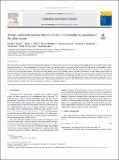| dc.contributor.author | Mazarico, Erwan | |
| dc.contributor.author | Neumann, Gregory A. | |
| dc.contributor.author | Sun, Xiaoli | |
| dc.contributor.author | Torrence, Mark H. | |
| dc.contributor.author | Mao, Dan-dan | |
| dc.contributor.author | Zuber, Maria | |
| dc.contributor.author | Genova, Antonio | |
| dc.contributor.author | Smith, David Edmund | |
| dc.date.accessioned | 2018-10-30T18:21:10Z | |
| dc.date.available | 2018-10-30T18:21:10Z | |
| dc.date.issued | 2018-02 | |
| dc.date.submitted | 2017-12 | |
| dc.identifier.issn | 0032-0633 | |
| dc.identifier.uri | http://hdl.handle.net/1721.1/118808 | |
| dc.description.abstract | The scale of the solar system is slowly changing, likely increasing as a result of solar mass loss, with additional change possible if there is a secular variation of the gravitational constant, G. The measurement of the change of scale could provide insight into the past and the future of the solar system, and in addition a better understanding of planetary motion and fundamental physics. Estimates for the expansion of the scale of the solar system are of order 1.5 cm year[superscript −1]AU[superscript −1], which over several years is an observable quantity with present-day laser ranging systems. This estimate suggests that laser measurements between planets could provide an accurate estimate of the solar system expansion rate. We examine distance measurements between three bodies in the inner solar system – Earth's Moon, Mars and Venus – and outline a mission concept for making the measurements. The concept involves placing spacecraft that carry laser ranging transponders in orbit around each body and measuring the distances between the three spacecraft over a period of several years. The analysis of these range measurements would allow the co-estimation of the spacecraft orbit, planetary ephemerides, other geophysical parameters related to the constitution and dynamics of the central bodies, and key geodetic parameters related to the solar system expansion, the Sun, and theoretical physics. | en_US |
| dc.publisher | Elsevier BV | en_US |
| dc.relation.isversionof | http://dx.doi.org/10.1016/J.PSS.2018.02.003 | en_US |
| dc.rights | Creative Commons Attribution-NonCommercial-NoDerivs License | en_US |
| dc.rights.uri | http://creativecommons.org/licenses/by-nc-nd/4.0/ | en_US |
| dc.source | Elsevier | en_US |
| dc.title | Trilogy, a planetary geodesy mission concept for measuring the expansion of the solar system | en_US |
| dc.type | Article | en_US |
| dc.identifier.citation | Smith, David E., et al. “Trilogy, a Planetary Geodesy Mission Concept for Measuring the Expansion of the Solar System.” Planetary and Space Science, vol. 153, Apr. 2018, pp. 127–33. © 2018 The Authors | en_US |
| dc.contributor.department | Massachusetts Institute of Technology. Department of Earth, Atmospheric, and Planetary Sciences | en_US |
| dc.contributor.mitauthor | Smith, David E. | |
| dc.contributor.mitauthor | Zuber, Maria | |
| dc.contributor.mitauthor | Genova, Antonio | |
| dc.relation.journal | Planetary and Space Science | en_US |
| dc.eprint.version | Final published version | en_US |
| dc.type.uri | http://purl.org/eprint/type/JournalArticle | en_US |
| eprint.status | http://purl.org/eprint/status/PeerReviewed | en_US |
| dc.date.updated | 2018-10-05T12:58:00Z | |
| dspace.orderedauthors | Smith, David E.; Zuber, Maria T.; Mazarico, Erwan; Genova, Antonio; Neumann, Gregory A.; Sun, Xiaoli; Torrence, Mark H.; Mao, Dan-dan | en_US |
| dspace.embargo.terms | N | en_US |
| dc.identifier.orcid | https://orcid.org/0000-0003-2652-8017 | |
| dc.identifier.orcid | https://orcid.org/0000-0001-5584-492X | |
| mit.license | PUBLISHER_CC | en_US |
